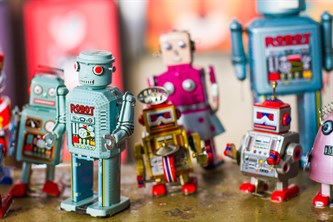CES, held last week in Las Vegas, is the annual global consumer tradeshow for techmarketers and gadget-obsessed technophiles. The show provides a snapshot into the new world of innovations and how they will impact our audiences. With emotive robots, virtual reality and holographic computing making a massive impact on this year's show and audience, are they really worth the time, effort and investment for marketers?
Virtual and augmented reality
Having grown its CES presence by 68% this year, virtual and augmented reality is beginning to prove its worth, making investment in these technologies far more appealing. With Facebook's Oculus VR and Sony Electronics showing us how to co-create content to embed products in immersive experiences that align with a brand, the savviest marketers will be imagining their own ways to make this medium a commercial success.
In the past, virtual reality headsets may have been a little rough around the edges, but Oculus and HTC have come a long, long way. There are still the obvious challenges like spatial audio, shared experiences and straight up resolution, but the products we see now are refined enough to offer real consumer value - if customers can stomach the cost.
Wearables
The wearable crusade continues as digi-health leads the charge with even more innovative health monitoring devices. However, the on-going issue for this technology is genuine "wearability" with many consumers refusing to wear "ugly" devices. Up until now, the wearable aesthetic had been taking away from the devices' usability, but CES saw some pretty funky-looking new designs this year.
For example, Fitbit announced the Fitbit Blaze, a basic smartwatch that retains the company's focus on fitness with a digital personal trainer, heartrate measurement and GPS tracking - while being suitably slick. Meanwhile, HTC announced a partnership with Under Armour, which will see the two companies launching the action-hero style UA HealthBox; a $400 fitness system. With new technologies becoming more attractive to the consumer, we'll see more marketers experiment with wearable tech.
Emotive Robotics
Emotive robotics excited marketing audiences in Vegas with new possibilities for delivering highly contextual content. As shown in Japan, Pepper the emotional android created by Softbank, boasted of its customer service functionalities, has been tested in banks and stores to date. Promoting the value of 'emotional robot' means that Pepper is not a serviceable domestic creation, leaving us wondering about its other capabilities. At $2,000 a pop, this might not be the wisest investment to make today, but it is still an investing area for marketers to watch.
So, where is best to invest?
As exciting as innovative new gadgets are, it's important to consider whether your business' structure and goals are compatible before investing. To truly impact a business, a well thought-out strategy is key. And at times this means saying no, or not right now, to some of the most exciting, yet completely unproven gadgets and technologies to be unveiled. Better to wait and see what consumer uptake is like before throwing lots of money at something that's cool, but could go the same way as the Sinclair C5.
This article was first published in More About Advertising

